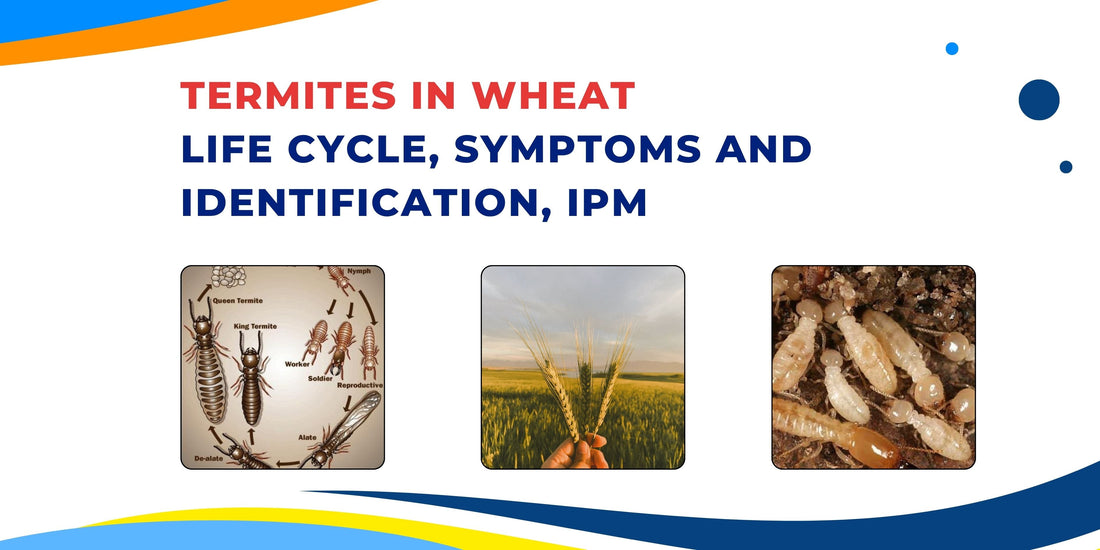
TERMITES IN WHEAT LIFE CYCLE, SYMPTOMS AND IDENTIFICATION
Termites, belonging to the order Isoptera, are serious soil-inhabiting pests of wheat and other cereal crops. They are social insects that live in colonies and feed on organic matter, including crop residues, wood, and living plant tissue. In wheat-growing regions of India, termite infestation is most common under rainfed, sandy loam, or light-textured soils, particularly in Northwestern and Central India.
Key Species Affecting Wheat:
- Odontotermes obesus
- Microtermes obesi
- Heterotermes indicola
These species live underground and attack wheat plants from the roots upward, feeding on roots, basal stem portions, and sometimes the grains. Termites are highly organized, with colonies comprising workers (feeders), soldiers (defenders), and reproductives (queen and king). The worker caste causes most of the crop damage.
Life Cycle and Biology
Termites reproduce through eggs laid by the queen deep in the soil. Their development follows the stages:
Egg → Nymph → Adult (Worker/Soldier/Reproductive)

-
Favorable Conditions:
Termite activity is highest under warm, dry conditions, especially when soil moisture is low and organic matter is abundant (e.g., in stubble-retained fields). -
Survival and Spread:
They survive between crops by feeding on leftover crop residues, roots, or wooden materials in the soil. During the wheat season, they move from nearby termitaria or infested stubbles toward standing wheat plants, especially at germination or tillering stages.
Symptoms and Identification
Termite damage often goes unnoticed in the early stages because they attack underground. Farmers can identify infestation by observing:
- Drying and premature wilting of plants even when soil moisture is adequate.
- Lodging or easy uprooting of plants due to root and basal stem damage.
- Hollowed stems and roots, filled with soil particles.
- Presence of earthen/mud galleries on roots or at the base of plants.
- Patchy crop appearance across the field.
Field Diagnostic Tip:
Dig around the base of affected plants—if termites or mud tunnels are visible near roots, the infestation is confirmed.
Economic Impact
Termites can cause 10–30% yield loss, and in severe cases, damage may reach up to 50%, particularly in unirrigated fields.
Indirect losses include:
- Poor seed germination in infested soils
- Weak plant stands due to root injury
- Hidden losses at early crop stages or during dry spells
Their cryptic (hidden) feeding makes damage detection difficult until significant crop loss occurs.
Integrated Pest Management (IPM)
1. Cultural Practices
- Deep ploughing in summer to expose termite colonies to sun heat and predators.
- Destroy old stubbles, roots, and wooden debris before sowing.
- Practice crop rotation with non-host crops (e.g., pulses, oilseeds).
- Maintain field hygiene and avoid leaving residues that support termite colonies.
2. Seed Treatment
Treating seed before sowing is the most economical and effective control measure.
Recommended Chemicals:
- Imidacloprid 17.8% SL @ 1.5 ml/kg seed
- Fipronil 5% SC @ 2.5 ml/kg seed
- Chlorpyrifos 20% EC @ 10 ml/kg seed (use with caution and safety measures)
Seed treatment protects seedlings during early vulnerable stages and reduces soil population of termites.
3. Soil and Field Treatment
- Apply Chlorpyrifos 20 EC @ 5 L/ha mixed with 800–1000 L of water as a pre-sowing soil drench or during the first irrigation.
- For standing crops, spot drenching around infested patches can help contain spread.
4. Biological Control
Encourage the use of bio-control agents such as:
- Metarhizium anisopliae
-
Beauveria bassiana
These entomopathogenic fungi infect and kill termites naturally and are compatible with eco-friendly pest management systems.
5. Monitoring & Advisory
- Farmers should inspect fields regularly, especially during dry conditions.
- Extension workers and agri-input dealers can play a key role in early detection, seed treatment promotion, and safe handling training.
- Use pheromone-based or soil disturbance indicators to monitor termite presence.
Recommendations for Input Sector
Product Promotion Opportunities:
- Seed treatment products: Encourage the use of imidacloprid or fipronil-based formulations.
- Soil-applied insecticides: Develop awareness campaigns for pre-sowing or irrigation-based termite management.
- Biological products: Promote Metarhizium anisopliae or Beauveria bassiana formulations as part of IPM kits.
Extension and Farmer Support:
- Conduct field demonstrations on the benefits of treated seed vs. untreated seed.
- Distribute seasonal advisory messages, such as:
“Protect your wheat from termite attack – treat seed with Imidacloprid 17.8% SL @ 1.5 ml/kg before sowing.”
- Partner with Krishi Vigyan Kendras (KVKs), cooperatives, or local dealers to provide training on IPM practices.
- Emphasize safe use, proper dosage, and environmental responsibility in product communication.

